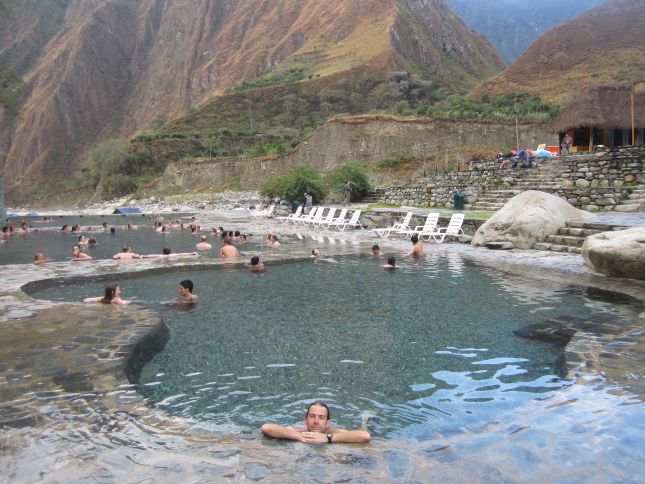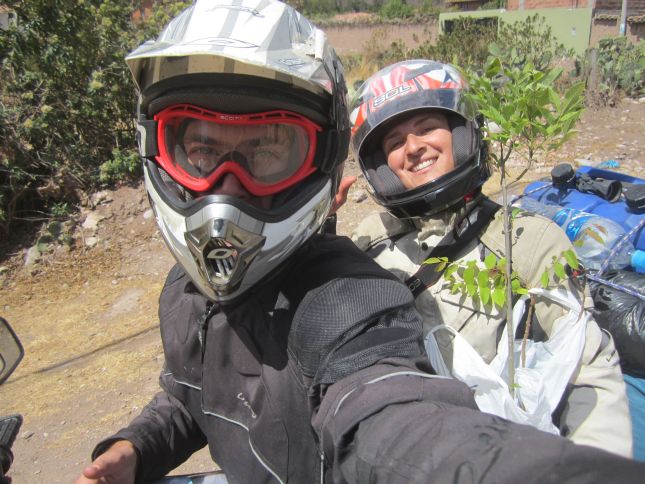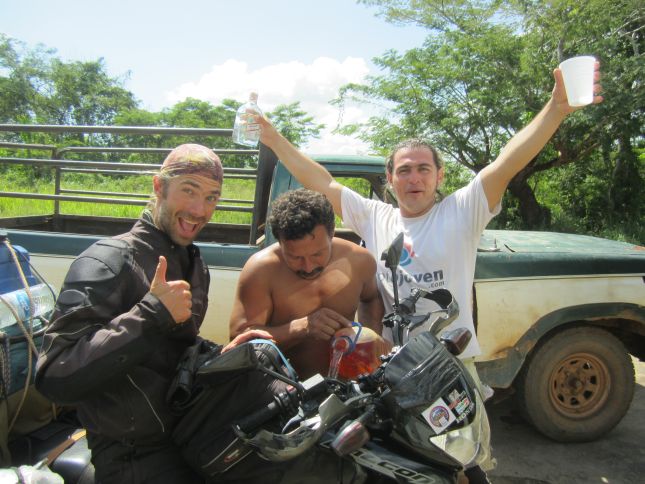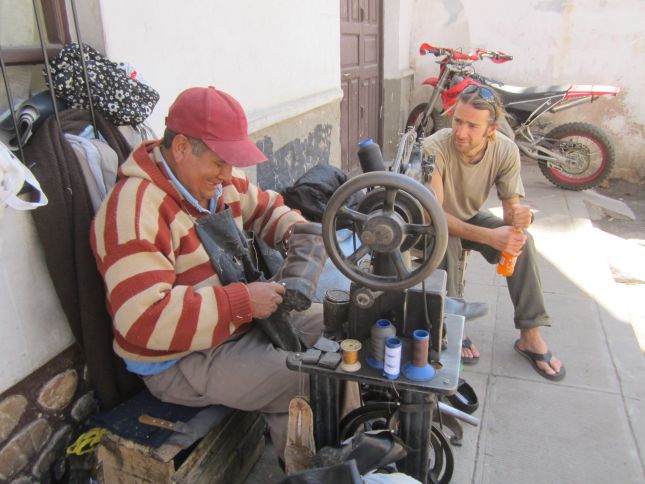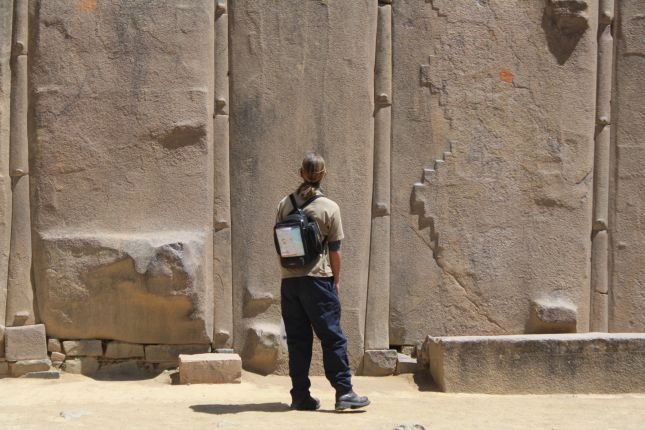
A Step Into the Past – Ollantaytambo, Peru
TRIP INFO BOX |
|
| Route | Cuzco, Peru – Ollantaytambo, Peru (RN3S,RN28B) |
| Distance | 70Km |
| Travel Time | 2 hours |
| Road Conditions | Good tarmac |
| Weather | Sunny & cloudy |
| Terrain | Mountain valleys |
| Food and Petrol | Cuzco, Urubamba |
| Accommodation | Las Portadas, Ollantatambo |
Our route chose, we leave Cuzco to the NorthWest on the Av. del Ejercito and inevitably, end up lost as the main avenue ends and no clear continuation seems to be in existence. No matter though, a few pointers from some friendly Cuzqenians and we’ve soon found the secret passage which connects the main avenue out of town to the rest of the main avenue out of town.
This road heads out over the mountains past Chinchero and leads into the Sacred Valley (Valle Sagrada), which holds a multitude of archeological treasures from Incan times. We ride on good tarmac, occasionally a bit bumpy, and the views get spectacular as we reach the Sacred Valley, about 50Km out of Cuzco. Spread out in front of us is a long valley, green and fertile, cut by a river and guarded by steep, brown mountains either side, whose slopes are stepped with agricultural terraces. On the way down we notice several signboards marking the entrances to various historical sites we recognize from our (well, Ebru’s) Sacred Valley trip research, such as Maras and Moray.
Upon reaching the valley’s base we are in Urubamba, a small town with a an inviting vibe, where we fill up at an equally inviting petrol station. They are playing music at the pumps, creating a cheerful mood. The petrol price, at 13.61PEN per Gallon or 2.99PEN (1.16USD) per Litre, is sadly not as cheerful as that of Bolivia, but it could be worse. I see a lady come by to buy firewood there – she walks away with a stack of eucalyptus logs. At this point my mind starts to wonder….
Something I have not yet mentioned is that, since our entry into Peru, one thing that has become quite abundant is the presence of Eucalyptus trees. It looks like they have managed forests here – perhaps not really “forests”, rather “plantations”. The trees are planted, raised, harvested, the wood is used in building or as fuel. In any event, this impresses me immensely as I don’t recall seeing such an organized effort to date, definitely not in Bolivia. And of course, the smell that suffuses the air is heavenly!
The synapses in my brain start to fire uncontrollably and conjure up mixed images of eucalyptus wood, fire and meat. We’ve just filled up with petrol and we must move on, but a seed has been planted… Onwards to Ollantaytambo!
Talking about seeds being planted: here we also complete our 17th & 18th “Planting Around the World” mission! Read this article for the details…
Further inside Ollantaytambo we find the hostels to be a bit more expensive so we park up at Hostal Los Portadas (40PEN/dbl) for the night. It’s simple, but it’s quaint and it has a beautiful garden.
Ollantaytambo town is a fascinating work of grey stone buildings on stone floors. There is an ever-present rushing of water in the air, which is because of several water canals that were created here by the Incan predecessors (possibly repaired and/or maintained by successors). Indeed, these waterways give the town part of its flair. The other main actors are the ruins flanking you… of a military outpost -slash- agricultural station on a grand scale.
Powerful folk these Incans must have been to drag all those rocks around, and steep as hell as well. But then that’s what the fresh mountain air does to you. 🙂
There’s a number of restaurants, bodegas, hostels, all quite quaint looking and cafe with decent coffee and decent hot chocolate at the plaza (I can’t remember the name but it’s at the plaza, to the left of the road leading down to the ruins). For dinner, what I would recommend is trying one of the eucalyptus wood roasted chickens in one of the traditional pollo asado restaurants. There’s at least one at the plaza.
All over town there are people selling the traditional Peruvian textiles and handicrafts, decorating the town with those vigorous colours that are so typical in these parts. And to complement that, every stone nook and cranny is filled with pretty little flowers. A really pretty place!
That night we visit the Quechua Pisco Sours bar just near the ruins entrance. It’s a cozy looking place with good music playing, an upstairs, downstairs and outside seating arrangement and a bar. They have various Pisco Sour recipes and a number of specials going on, and they’re delicious, so this is the place to be! We let ourselves go a bit as we allow ourselves to indulge in the Pisco offerings, the mood being good as it is, we soon find ourselves in cheery conversation with the bar tenders and a few English girls about to embark on the Inca Trail. A fun night out.
The next morning we enter the ruins. The ticket price was 130PEN each for a ticket that covers entry into all of the major Sacred Valley sites (even some in Cuzco I believe) over 10 days. The other option would have been a cheaper (ca. 70PEN) 1-day ticket covering only 3 Sacred Valley sites, as I recall it. Some of the smaller Sacred Valley sites like Moray allow for individual entry tickets (10PEN), but what I understood is that for the main sites like Pisac, Ollantaytambo and Chinchero you’re tied in to either the 3- or the 10-day combo ticket.
We don’t manage all of the sites even with our motorcycle, but we do obviously have our Machu Picchu trek booked smack-bang in the middle of those 10 days.
The Ollantaytambo ruins are astonishing. Walking around among them gives you a sense of what life may have been like for the people up here on these steep slopes, overlooking this broad trilateral intersection of rivers. The large stones stacked upon one another to form walls and floors show a carve so exact it seems air tight. Precision engineering from another millennium. Makes me ponder about the elegance of our sophistication – corrugated iron, plaster board, concrete…
We have entered the ruins on the left using the main entrance, but on the mountain face on the opposite side we can see additional buildings that formed part of this complex. Soldier barracks and other buildings clinging like weeds to the rocks. A lookout-post stooped on a protruding rock a hundred or so metres up; so naturally camouflaged you have to look hard to find it again once you cast your view elsewhere. And Incan planting terraces everywhere in between.
As far as ancient ruins in Peru go, this has been impressive and worth the time and ticket cost. It promises to get better as we move along. We’re very excited!
